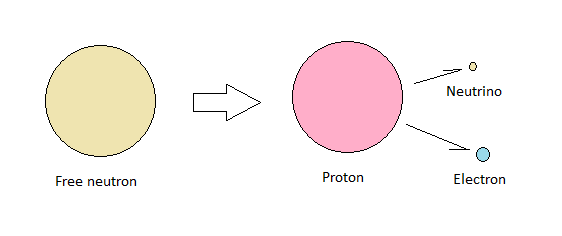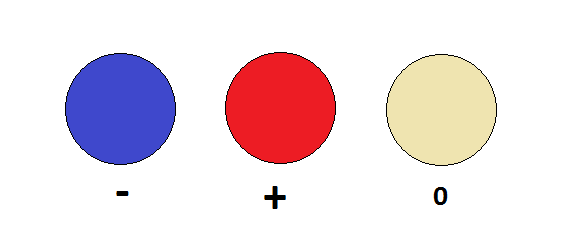We have now arrived at a point where we can use our theoretical base to interpret real world experiment and observations. Our first task will be to describe the four stable particles that make up the entirety of the universe.
These particles are:
- The proton
- The electron
- The neutrino
- The photon
All other particles are either unstable, and in some way related to the above list, or an assembly of the above. A model that describes the above list of particles is therefore essential for our understanding of all particles.
To aid us in this, we’ll consider the phenomenon of free neutron decay, and the phenomenon of electron-positron pair production:
Free neutron decay
The particle quanta described in this book are based on Morton Spears’ particle quanta, used by him in his work on gravity. His thinking was based on data available at his time. In particular the relative masses of the proton, neutron and electron. These are measures that have changed since he wrote his books back in the 1990’s. However, there’s still general agreement that the proton is smaller than the neutron by a single electron and an anti-neutrino, which is all we need in order to make our calculations.
When Spears realized that the difference in mass between a proton and a neutron could be expressed as a ratio of 2177 to 2180, he drew the straight forward conclusion that the difference between a proton and a neutron must be 3 particle quanta, 1 positive and 2 negative. Furthermore, the fact that the neutron has an overall neutral charge was interpreted to mean that a neutron consists of 1090 positive quanta and 1090 negative quanta. The fact that the proton has a positive charge of 1 was interpreted to mean that it’s composed of 1089 positive quanta and 1088 negative quanta.
From this we can find out what the 3 remaining particle quanta may be by considering the phenomenon of free neutron decay, in which a neutron, removed from an atomic nucleus, decays into a proton, an electron and an anti-neutrino within about 15 minutes.

One way we can interpret this is to assume that an electron consists of a single negative quantum, and the neutrino is an assembly of one negative and one positive quantum. However, the electron is generally understood to be larger than a neutrino. It’s therefore logical to conclude that the electron is constituted of 3 particle quanta: 2 negative and 1 positive. The neutrino becomes in this way something separate from the original assembly. It must have come from the aether rather than the neutron. Being smaller than the electron, we can conclude that the neutrino must be a single neutral quantum.
We can further concluded that the neutron isn’t a fundamental particle, but an assembly of 1 proton and 1 electron. This assembly is only stable inside the atomic nucleus. This in turn leaves us with three stable particles. They are:
- The proton
- The electron
- The neutrino
Left unaccounted for, we have the photon. However, once we consider the phenomenon of electron-positron pair production, the constituent parts of the photon come out clearly defined.
Electron-positron pair production
When high energy photons, such as gamma-rays come into close contact with large charged particles, they sometimes disappear spontaneously into nothing but an electron and a positron. At the very moment that the photon disappears, an electron-positron pair comes into existence.
The way we explain this in terms of our strict particle model, where no particle quanta can be created or destroyed, is that the photon is ripped apart:

We conclude that the particle quanta making up the electron and the positron are the same particle quanta that made up the original photon. Given that the electron and positron have identical mass, but opposite charge, we can further conclude that the positron is made up of 1 negative quantum and 2 positive quanta. Since the electron is made up of 1 positive quantum and 2 negative quanta, we get that the total assembly for a photon is 3 positive quanta and 3 negative quanta.
Our four stable particles have thus been explained in terms of particle quanta:
- Protons consist of 1089 positive quanta and 1088 negative quanta, a total of 2177.
- Electrons consist of 1 positive quantum and 2 negative quanta, a total of 3.
- Neutrinos consist of 1 neutral quantum.
- Photons consist of 3 positive quanta and 3 negative quanta, a total of 6.
Real world particle quanta
All of this gives support to our model. Morton Spears’ particle quanta correspond neatly to our three theoretical quanta as follows:
- Abrasive quanta are positive (+)
- Woolly quanta are negative (-)
- Mixed quanta are neutral (0)
For illustration purposes, we can use blue for negative particle quanta, red for positive particle quanta, and beige for neutral particle quanta:

Our theory doesn’t require any further explanation of this arrangement. However, I’m inclined to think that particle quanta are bundles of paired strings. Negative quanta consist of two woolly strings bundled together. Positive quanta consist of two abrasive strings. Neutral quanta consist of one woolly and one abrasive string. If this is the arrangement, and the distribution is random, we can expect there to be twice as many neutrinos as there are either positive or negative quanta. This would mean that there is a superabundance of neutrinos in the universe.
The assignment of woolly texture to negative particle quanta, and abrasive texture to positive quanta is not arbitrary. Rather, this assignment is essential in order to explain the enormous size of the proton relative to the electron.
The size of protons
Compared to the electron, the proton is surprisingly large, and its size seems arbitrary. Latest figures from experimental science has the proton 1836 times more massive than the electron. In terms of its constituent electrons and positrons used in our theory, it’s more than 600 times as large. Either way, the proton is huge.
The reason for the difference between size in terms of mass and size in terms of constituent parts is that mass includes binding energy, while constituent parts don’t. Hence, we have a mass that’s 3 times larger than the building blocks would have had without the addition of binding energy. However, this doesn’t explain why protons are as big as they are. To understand this in terms of our theory, we have to consider the effect of texture on particle assemblies.
Electrons are negatively charged and therefore predominantly woolly, while protons are positively charged and therefore predominantly abrasive. Abrasive textures are slightly more reactive than woolly textures. The analogy that springs to mind is Velcro. Anyone who has toyed with Velcro knows that woolly strips don’t react with other woolly strips. However, abrasive strips do react ever so slightly with other abrasive strips. Similarly, woolly electrons don’t combine with other negatively charged particles. Protons on the other hand are able to react weakly with other positive particles. This allows positively charged particles to assemble into larger structures than negatively charged particles.
A logical consequence of this is that the proton may under certain conditions be able to gobble up both an electron and a positron, growing a bit in the process. If so, protons may have originally started out fairly small, but grown over time to their current. As it turns out, this appears to be the case. About fifty years ago, the astronomer Halton Arp made the remarkable observation that young astronomic structures appear to be constituted of atoms that are lighter than corresponding atoms in older structures. This means that we have observational support for our suggestion that protons grow larger over time.
Energy
Sticking with our theory, we must take the position that energy is a property of particle quanta. This is especially true since we know that neutrinos, consisting of single neutral particle quanta, are capable of carrying energy. Energy is therefore something fundamental, requiring no complex assembly or structure to exist.
As stated at the beginning of this book, particle quanta have four fundamental properties. They are their 3 dimensions, their size, motion and texture. Additionally, we can propose vibration and spin as fundamental.
Neutrinos don’t speed up or slow down when given extra energy, so energy cannot be speed. Dismissing the idea that dimensions or texture may have anything to do with energy, we are left with spin, vibration or size as top contenders. Noting that large particles, such as protons, are known to carry more energy than smaller particles such as electrons and photons, our prime candidate becomes size.
For reasons that will become clear in our chapter on kinetics, we choose surface areas of particles as our definition of energy. From this, we get that any change in surface areas of subatomic particles equate to a change in energy.
With this definition of energy, we immediately get an explanation for binding energy, and why this translates into more inertia.
The proton is three times more massive than its constituent parts because these parts are stretched out in such a way that their surface area become three times what they are when not assembled into protons.
Keeping things together
From the above analysis, a number of aspects related to our theory have transpired.
Implicit in our above argument has been the idea of affinity between positive and negative particles. Assemblies are formed due to the natural affinity between woolly and abrasive particle quanta. Velcro is the macro-world analogy that best fits this idea.
Conventional physics invokes a nuclear strong force in order to explain particle assemblies. This short range force doesn’t exist in the model proposed in this book. Rather, we explain all short range affinities in terms of textures, which by definition must be short range.
While woolly and abrasive particle quanta react strongly with each other, mixed particle quanta don’t. Mixed particle quanta, known to us as neutrinos, don’t take part in assemblies.
Being a mix of woolly and abrasive textures, neutrinos carry footprints of what they have most recently been in contact with. Neutrinos that have recently been in contact with a woolly particle will be more abrasive than average. Conversely, a neutrino that has recently been in contact with an abrasive particle is more woolly than average. The more abrasive or woolly an assembly is, the bigger and more pronounced are the footprints left on neutrinos after collisions. Note that only neutrinos have this property. Woolly particles remain woolly, no matter what. The same goes for abrasive particles.
This is why neutrinos come in different charges and charge intensities, while protons, electrons and photons don’t.
< Fundamentals ———— | ———— The aether >